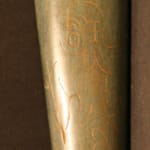Olmec Jade Celt, 900 BCE - 500 BCE
Jade
13.5
SP.176
Further images
The Olmecs are generally considered to be the ultimate ancestor of all subsequent Mesoamerican civilisations. Thriving between about 1200 and 400 BC, their base was the tropical lowlands of south...
The Olmecs are generally considered to be the ultimate ancestor of all subsequent Mesoamerican civilisations. Thriving between about 1200 and 400 BC, their base was the tropical lowlands of south central Mexico, an area characterized by swamps punctuated by low hill ridges and volcanoes. Here the Olmecs practiced advanced farming techniques and constructed permanent settlements. However, the consolidation of their city-states led to notable cultural influence far beyond their heartland, and throughout the Mesoamerican region. It would appear that the Olmec style became synonymous with elite status in other (predominantly highland) groups, with evidence for exchange of artefacts in both directions. A non-literate group, the Olmecs nevertheless paved the way for the development of writing systems in the loosely defined Epi- Olmec period (c. 500 BC). Further innovations include arguably the first use of the zero, so instrumental in the Maya long count vigesimal calendrical system. They also appear to have been the originators of the famous Mesoamerican ballgame so prevalent among later cultures in the region, and either retained or invented several religious symbols such as the feathered serpent and the rain spirit, which persisted in subsequent and related cultures until the middle ages.
Comparatively little is known of their magico- religious world, although the clues that we have are tantalizing. The art forms for which the Olmecs are best known, the monumental stone heads weighing up to forty tons, are generally assumed to pertain to some form of kingly leader or possibly an ancestor. The smaller jade figures and celts are believed to be domestically or institutionally based totems or divinities. The quality of production is astonishing, particularly if one considers the technology available for production, the early date of the pieces, and the dearth of earlier works upon which the Olmec sculptors could draw. Some pieces are highly stylized, while others demonstrate striking naturalism.
Much of the Olmec vision of the world is symbolized in this elegant celt. The naked blade was identified with agriculture and food, since stone axe heads were used for clearing fields. However, a celt such as this one would have been used in important ritual ceremonies. In the Middle Formative Period (900 -300 B.C.), Celts were associated with ears of corn, the V-shape being associated with the husk from which the cob emerged. At La Venta (a coastal city near present day Tabasco), caches of celts were discovered planted vertically like miniature stelae. The blunt end of this Celt would suggest a similar use, and when placed in a vertical position its appearance is much more dramatic. In this stance the celt served to define the central axis mundi and the corners of the four-sided world, regarded as a cosmic maize field.
Comparatively little is known of their magico- religious world, although the clues that we have are tantalizing. The art forms for which the Olmecs are best known, the monumental stone heads weighing up to forty tons, are generally assumed to pertain to some form of kingly leader or possibly an ancestor. The smaller jade figures and celts are believed to be domestically or institutionally based totems or divinities. The quality of production is astonishing, particularly if one considers the technology available for production, the early date of the pieces, and the dearth of earlier works upon which the Olmec sculptors could draw. Some pieces are highly stylized, while others demonstrate striking naturalism.
Much of the Olmec vision of the world is symbolized in this elegant celt. The naked blade was identified with agriculture and food, since stone axe heads were used for clearing fields. However, a celt such as this one would have been used in important ritual ceremonies. In the Middle Formative Period (900 -300 B.C.), Celts were associated with ears of corn, the V-shape being associated with the husk from which the cob emerged. At La Venta (a coastal city near present day Tabasco), caches of celts were discovered planted vertically like miniature stelae. The blunt end of this Celt would suggest a similar use, and when placed in a vertical position its appearance is much more dramatic. In this stance the celt served to define the central axis mundi and the corners of the four-sided world, regarded as a cosmic maize field.





